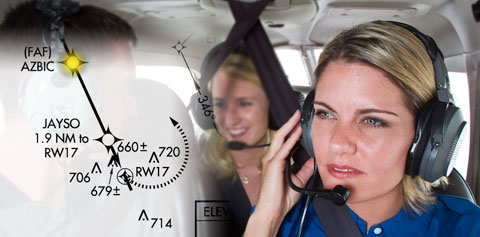
Remember when you were a student pilot flying the traffic pattern? Sometimes, mixed in with the familiar radio calls from other pilots, you would hear a puzzlingly problematic position report proffered in an utterly unfamiliar vocabulary.
![]() Being uncertain about those odd transmissions wasn’t a good feeling. Where does one look for an aircraft inbound to land in York, Pa., that has reported “AZBIC inbound”? Misunderstandings can cause conflicts.
Being uncertain about those odd transmissions wasn’t a good feeling. Where does one look for an aircraft inbound to land in York, Pa., that has reported “AZBIC inbound”? Misunderstandings can cause conflicts.
Now, of course, you get it. A glance at York’s RNAV (GPS) RWY 17 approach reveals that AZBIC is the final approach fix, 5.9 nautical miles from the threshold. Inbound aircraft cross the fix at 2,400 feet, descending to the appropriate minimum descent altitude
Fine, but that’s gibberish to a student pilot or a VFR pilot who has not studied IFR infrastructure. To that pilot, a position report rendered in instrument-speak is ear-catching but meaningless.
Keep the knowledge gap in mind when you fly practice approaches at a nontowered airport and the radar controller says, “Change to advisory frequency approved.” That’s when, according to the Aeronautical Information Manual, “you should broadcast your intentions, including the type of approach being executed, your position, and when over the final approach fix inbound (nonprecision approach) or when over the outer marker or fix used in lieu of the outer marker inbound (precision approach). Continue to monitor the appropriate frequency (UNICOM, etc.) for reports from other pilots.”
Technically, you can comply but still offer absolutely no useful position information to a pilot unfamiliar with IFR terminology and procedures. So be sure to speak VFR as well; if the fix is 5.9 nm north of the airport, say so!
It’s educational and fun to fly an approach to minimums, and then land or go missed. But safety often demands compromise.
“If there is heavy VFR traffic and you’re on an instrument approach to other than the active runway, break off the approach before a conflict develops and enter normal traffic. Announce your intentions on the CTAF,” recommends this safety tip from the Air Safety Institute publication Operations at Nontowered Airports.
Workload causes some pilots to delay that initial call-up, but nothing wreaks more havoc than an aircraft elbowing everybody out of the way in a well-sequenced pattern. So add “timely” to your list of communications reminders for coexisting in aviation’s multilingual environment.



